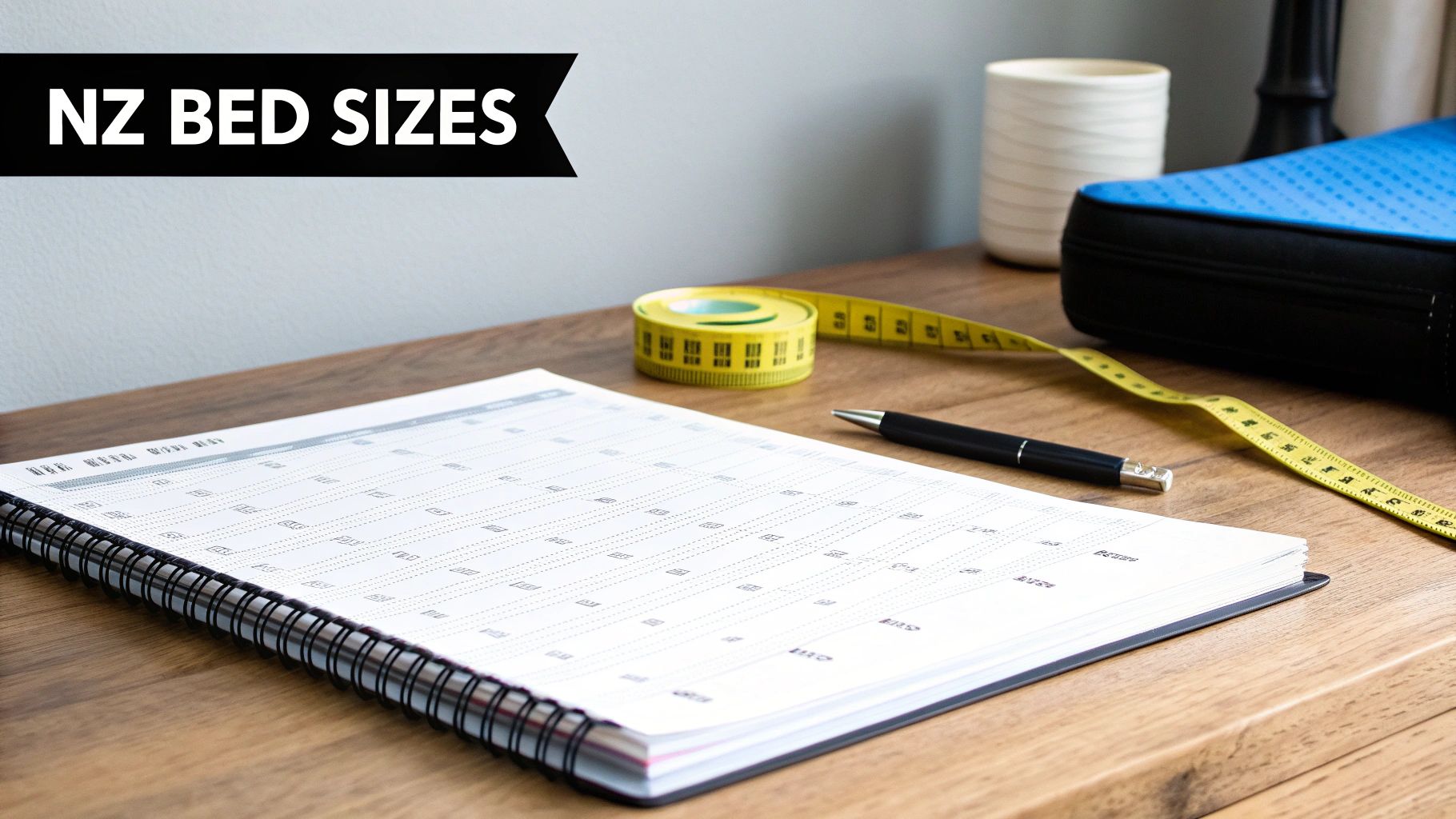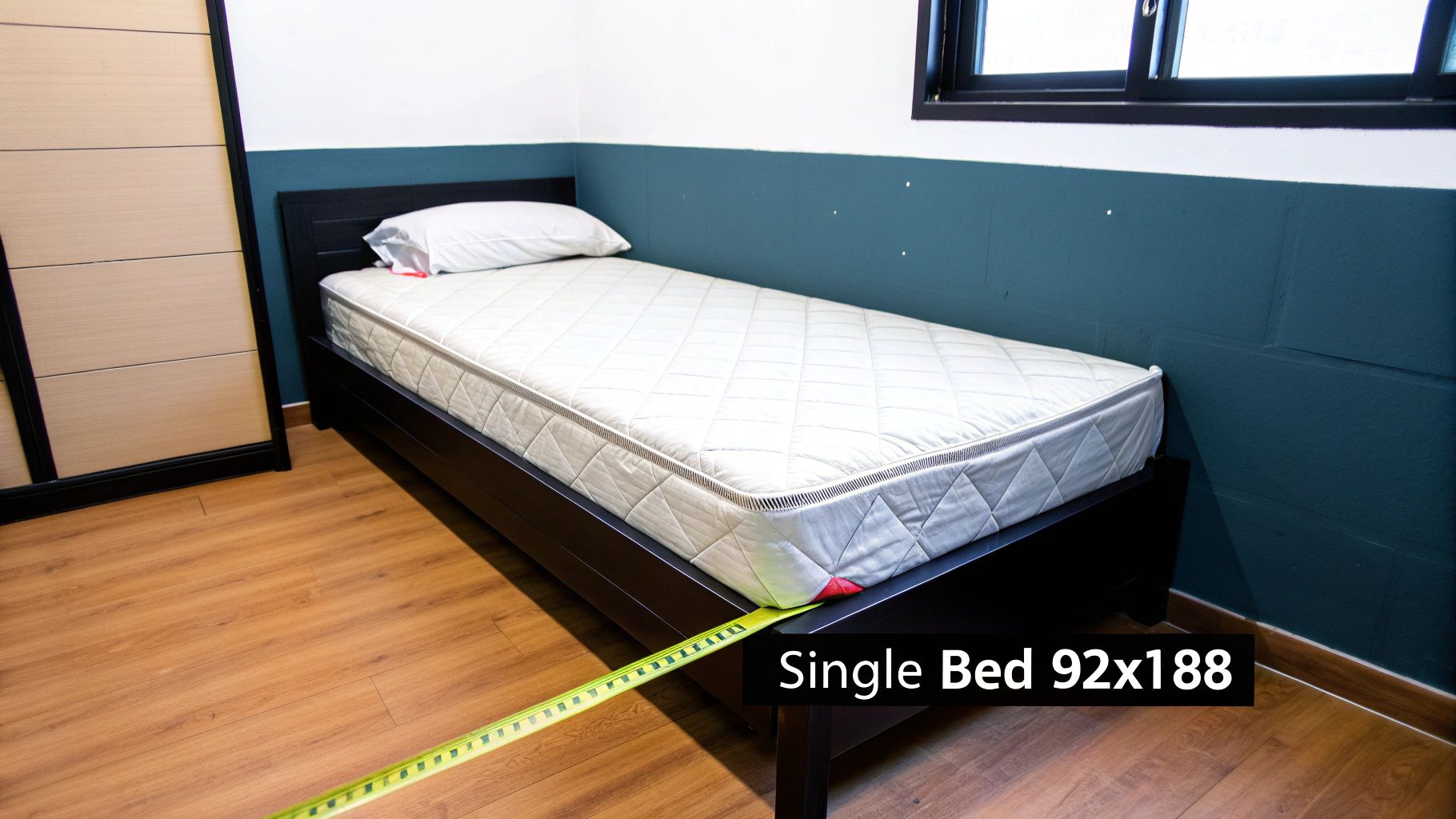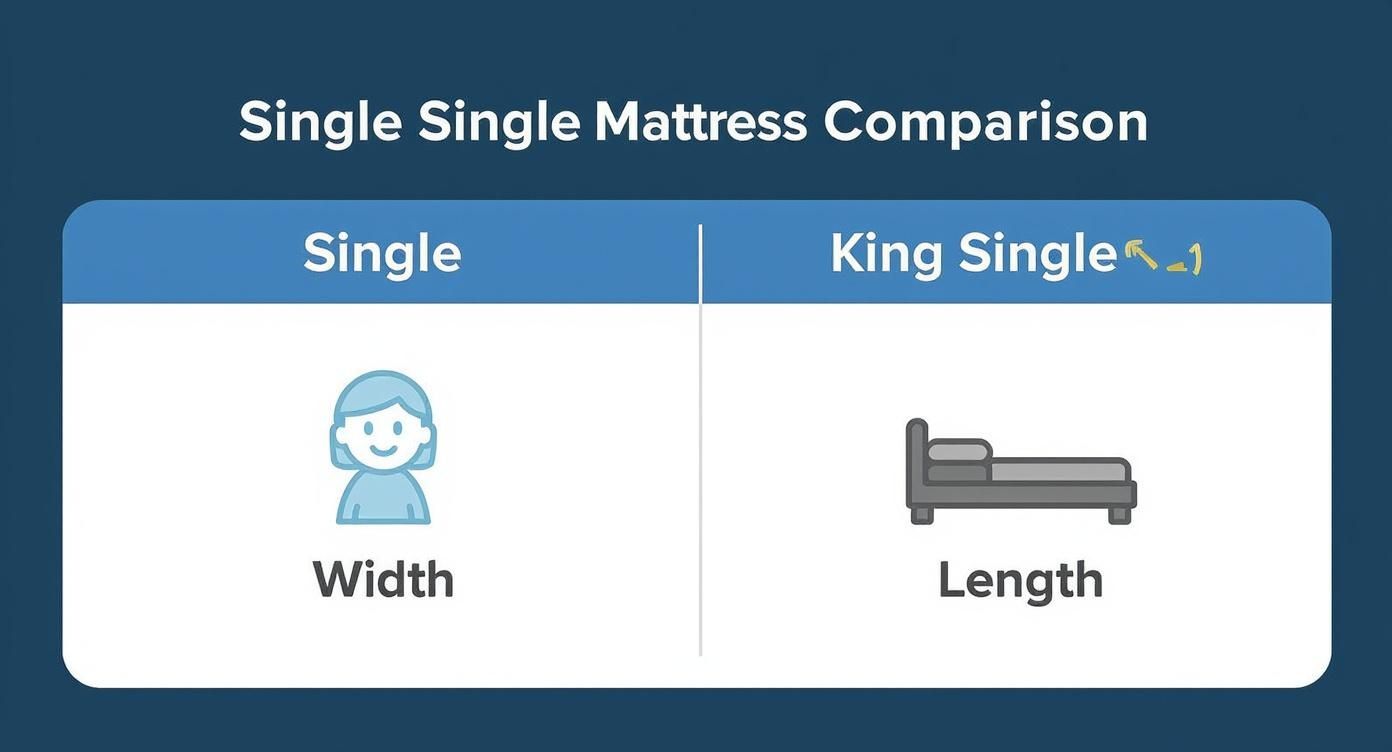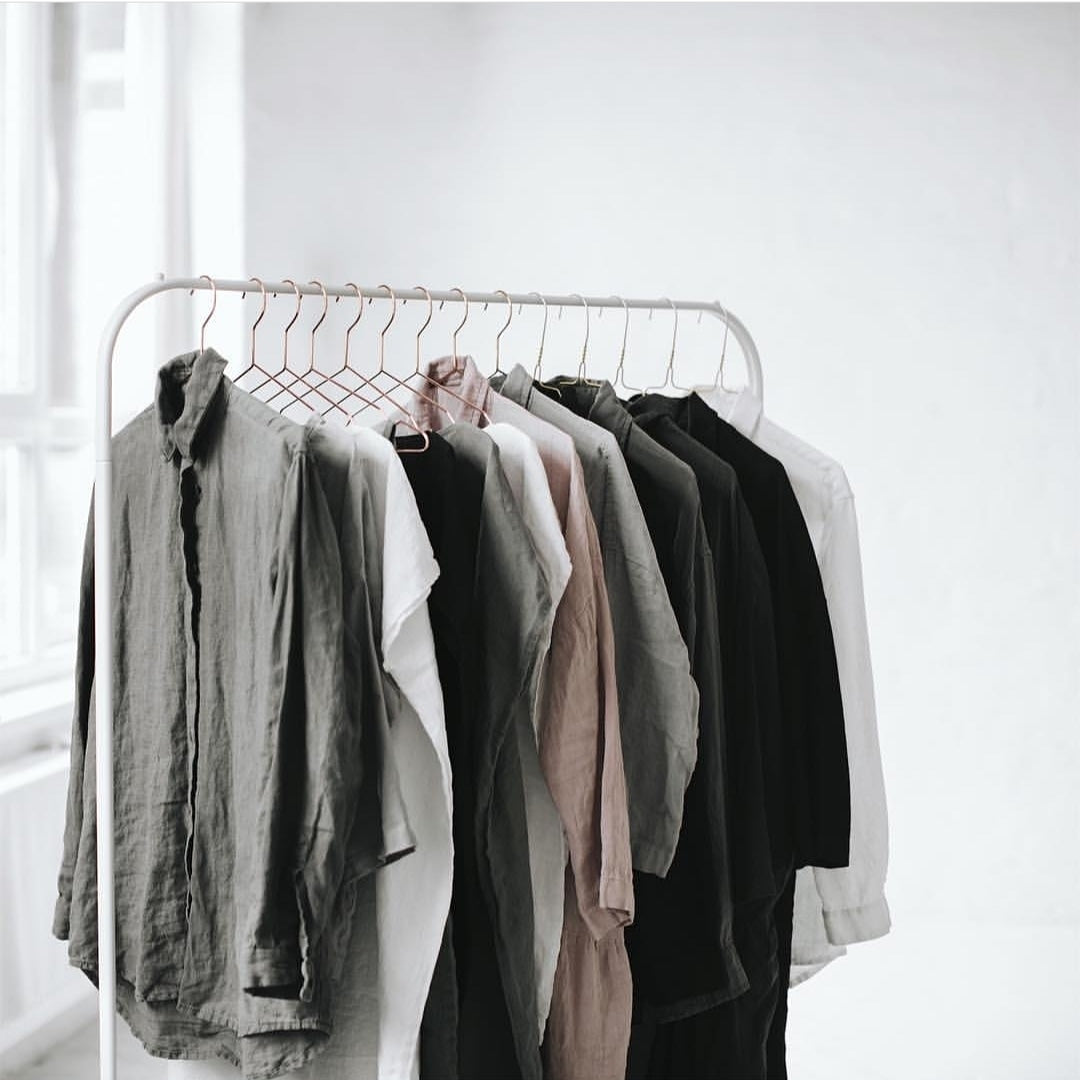Picking out a new bed is about so much more than just finding a comfy mattress. You've got to get the size right, otherwise everything from planning your room layout to buying linen can become a real headache. In New Zealand, a standard Single bed is 92cm x 188cm, while a King Single gives you that bit of extra space at 107cm x 203cm.
Knowing these exact numbers is the first step to making a smart choice and getting a bed that truly fits your space and your needs.
Your Quick Guide to NZ Bed Dimensions
Getting your head around the exact dimensions for a single and king single is key. It doesn't matter if you're setting up a kid's room, a guest bedroom, or trying to make the most of a small apartment – knowing these measurements helps you avoid those classic mistakes. Think buying sheets that just won't stretch far enough, or a bed frame that completely dominates the room.

It's been an interesting time for the New Zealand mattress market. Its value has dropped to NZ$31 million in 2024, which is a significant 16.2% decrease from the year before. But even with these shifts, single beds are still a go-to choice for many Kiwis. Thankfully, the standard sizing of 92 x 188 centimetres (3'0" x 6'2") has stayed consistent across the board. If you're curious, you can explore more about NZ bed market trends to see how these sizes fit into the bigger industry picture.
To help you visualise the difference, here's a simple reference table comparing the two.
Standard NZ Mattress Dimensions Quick Reference
This table gives you a quick, at-a-glance comparison of the two main single bed sizes you'll find in New Zealand, showing both metric and imperial measurements.
| Bed Size | Dimensions (cm) | Dimensions (inches) |
|---|---|---|
| Single | 92cm x 188cm | 36" x 74" |
| King Single | 107cm x 203cm | 42" x 80" |
Having these numbers handy makes it much easier to decide which size is right for you before you start thinking about room layouts or shopping for the perfect set of sheets.
The Classic Single Bed: A New Zealand Staple
The standard single bed is a true classic in Kiwi homes, and for good reason. It’s the go-to, space-savvy solution for all sorts of situations, measuring a neat 92cm x 188cm. This compact size makes it incredibly versatile.

It’s often the perfect choice for a child's first "big bed," slotting easily into smaller bedrooms without sacrificing precious floor space for play. But its usefulness doesn't stop there; it's also a smart pick for guest rooms, university halls, and those city apartments where every square metre counts.
Planning Your Room Layout
When you're mapping out a room, it's easy to focus only on the bed's footprint, but the real key to a functional space is the room you leave around it. You need to think about walking paths and access to other furniture.
A great rule of thumb is to leave at least 70cm of clearance on one side of the bed and at the foot. This gives you enough space to walk around comfortably, open wardrobe doors, or pull out drawers without feeling squeezed in.
- Minimum Room Size: For a single bed and not much else, you'll want a room that's at least 2.0m x 2.6m.
- Adding Furniture: If you're adding a desk or a chest of drawers, remember to factor in their depth plus the clearance space you'll need to use them.
For example, if you want to place a 60cm deep desk in the same room, you'd need a minimum room width of about 2.2m (that’s 92cm for the bed + 70cm for clearance + 60cm for the desk) to keep things from feeling cramped.
How to Dress a Single Bed
Finding linen for a standard single is generally simple, but here’s a pro tip for getting that plush, inviting look: go up a size with your duvet.
Using a double-sized duvet (180cm x 210cm) on a single bed allows it to drape beautifully over the sides, completely covering the mattress and giving it a much more luxurious feel. It’s a simple trick that makes the bed look professionally styled.
For your fitted sheets and mattress protectors, however, you’ll want to stick to the designated single size for a nice, snug fit. You can check out our collection of premium linen, all designed to perfectly fit these single and king single dimensions and bring a touch of style to any bedroom.
When to Choose a King Single Bed
When a standard single bed starts to feel a bit cramped, the king single is the perfect upgrade. It offers that welcome extra bit of width and length, making it a brilliant solution when you need more space than a single offers but don't quite have the room for a double.
It’s an especially smart choice for growing kids and teenagers. That extra room makes all the difference during growth spurts, giving taller kids plenty of space to stretch out without their feet hanging off the end. Think of it as a great long-term investment for a child's bedroom that will see them right through their teen years.
The Ideal Fit for Taller Sleepers
It's not just for kids, though. The king single is a fantastic option for adults who find a regular single just a little too restrictive. If you're over average height, that extra length is a game-changer for getting a comfortable night's sleep.
This size is also a hero in multi-purpose or smaller spaces. It works perfectly in:
- Guest Bedrooms: It gives visitors a much more comfortable stay than a standard single, without dominating a smaller room.
- Studio Apartments: For anyone sleeping solo in a compact home, it offers a slice of luxury and a better quality of sleep.
- Teenage Retreats: It’s the perfect bridge between a childhood bed and a full-sized adult one, giving them their own comfortable space.
The king single mattress is a popular middle-ground choice in New Zealand, measuring 107 cm x 203 cm. It provides a noticeable increase in space over a standard single while still being more compact than a double. For a full comparison, you can find more details on NZ mattress sizes on wisemove.co.nz.
A Long-Term Comfort Investment
Opting for a king single is often a decision about future-proofing comfort. Its generous size means it will last for years, easily transitioning from a kid's room to a young adult's space without needing to be replaced. That kind of longevity offers fantastic value.
Because it's such a common size, finding beautiful, well-fitting linen is also a breeze. Making the bed is simple, and it always looks neat and inviting. To really complete the picture and create a truly luxurious sleep setup, the next step is finding a quality king single sheet set. This guarantees your bedding will perfectly fit the generous single and king single dimensions of your mattress.
Navigating International Size Differences
If you've ever bought bed linen online or looked at furniture from overseas, you'll know that bed sizing can be a minefield. A "Single" bed isn't a universal standard, and what you get in the UK or the US can be quite different from what we have here in New Zealand. These small variations can turn into a big headache, leaving you with a mattress that doesn't fit your base or sheets that just won't stay put.
The trick is to forget the name—like "Single" or "Twin"—and pay close attention to the actual single and king single dimensions in centimetres.
This is particularly important when comparing our local sizes to those in Australia, the UK, and the US. For instance, the bed we call a King Single in New Zealand and Australia is much longer than a standard UK Single. And while a US Twin bed is a bit wider than our NZ Single at 96.5cm, it’s still noticeably narrower than our NZ King Single.
Global Size Variations at a Glance
Getting your head around these differences is key to avoiding costly mistakes. A few centimetres might not sound like much, but it’s the difference between a fitted sheet that grips the mattress perfectly and one that pings off the corners every night. Knowing the specifics will save you a world of frustration.
As you can see below, the jump from a Single to a King Single offers a serious upgrade in both width and length—a crucial factor if you're buying for a growing teenager who needs more room to stretch out.

The extra space a King Single provides is clear, making it a much better long-term choice for comfort and longevity.
Quick Tip: A common trap is assuming that because Australian and NZ King Single mattresses share the same dimensions (107cm x 203cm), any sheet will fit. Not always! Always double-check the fitted sheet’s pocket depth, as mattress heights can vary significantly between brands.
To help you shop with confidence, I've put together a quick comparison table of the most common international sizes. It’s a handy reference to keep in mind when looking at overseas brands.
Single & King Single Size Comparison (NZ vs. International)
This table breaks down the key differences in single bed dimensions across New Zealand, Australia, the UK, and the US.
| Region | Size Name | Dimensions (cm) | Notes |
|---|---|---|---|
| New Zealand | King Single | 107cm x 203cm | Our local standard. A great fit for teens and taller adults. |
| Australia | King Single | 107cm x 203cm | Identical to the NZ King Single mattress dimensions. |
| United Kingdom | Single | 90cm x 190cm | Considerably shorter and narrower than an NZ King Single. |
| United States | Twin XL | 96.5cm x 203cm | Same length as an NZ King Single but about 10cm narrower. |
Ultimately, having the exact measurements on hand is your best defence against buying the wrong size. For a more detailed look at all local standards, from cots to California Kings, check out our complete guide to bed sizes in NZ.
Finding Linen That Actually Fits Your Bed
So, you’ve picked out the perfect mattress. That's a great start, but the job isn't done yet. Getting the linen right is just as important for both the look of your room and a good night's sleep, and it’s amazing how often this part goes sideways. The detail everyone forgets? Mattress depth. This can be wildly different depending on whether you have a standard mattress, a plush pillow-top, or have added a memory foam topper.

There's nothing more annoying than a fitted sheet that’s too shallow—it will ping off the corners every night, leaving your bed a mess. On the other hand, a sheet that's far too deep just bunches up underneath you, creating uncomfortable lumps. The simple trick is to measure your mattress height before you even think about shopping.
Here in New Zealand, our bed market—slated to bring in US$27.92 million in revenue in 2025—uses standard sizing for single and king single beds. That consistency is helpful for width and length, but it almost never accounts for depth.
Mastering the Pocket Depth
When you're looking at fitted sheets, the magic number is the "pocket depth." This is simply the measurement of the corner seam, and it tells you exactly how deep a mattress the sheet is designed for. A little bit of easy maths is all you need to get it right.
First, get a measuring tape and find the exact height of your mattress, from the very bottom to the very top. Then, add at least 7-10cm to that number. This gives you enough extra fabric to tuck securely under the mattress, so it stays put all night long.
- Example: Let's say your king single mattress is 30cm deep. You’ll want a fitted sheet with a pocket depth of at least 37cm.
A sheet that fits snugly doesn't just look tidier; it protects your mattress and genuinely helps you sleep better. It’s one of those small details that makes a huge difference in how your bed feels.
Choosing Duvets and Flat Sheets
While your fitted sheet needs to be spot-on, you’ve got a bit more creative freedom with duvets and flat sheets. A great designer trick is to go one size up with your duvet. Putting a double duvet on a single bed, for instance, gives you that lush, draped look you see in magazines, ensuring the sides of the mattress are completely covered.
This same thinking applies to blankets and throws. To get the right look and feel, dimensions matter. It can be helpful to check out how larger options like King-sized blankets are styled to see how they drape. Nailing the linen sizing is the key to a comfy, beautifully made bed, so taking a moment to check these single and king single dimensions is well worth it.
For a deeper dive, be sure to check out our guide on NZ sheet sizes.
Common Measurement Mistakes to Avoid
Getting your single and king single dimensions right the first time is one of those simple things that saves a world of hassle later on. We've all been there—a tiny measurement error can lead to a bed frame that doesn't fit, sheets that refuse to stay put, or the logistical nightmare of returning a massive mattress. The good news is that the most common mistakes are also the easiest to sidestep with a bit of know-how.
One of the biggest slip-ups I see is people measuring their bed frame instead of the mattress. It seems logical, but a bed frame is almost always built slightly larger than the mattress it’s designed to hold. If you use the frame's dimensions to buy linen, you're starting with the wrong numbers.
How to Get it Right
For a truly accurate measurement, strip the bed completely. Get rid of the sheets, mattress protector, everything. Now, grab a firm, retractable steel tape measure. Soft, fabric tape measures, like the kind used for sewing, can stretch over time and throw your numbers off.
Pull the tape taut and measure directly from one edge of the mattress to the opposite edge. This simple step gives you the precise width and length you need for everything from choosing a new base to buying the perfect duvet.
Another classic mistake is forgetting about mattress depth. This is a big one. Standard mattress sizes only cover width and length, but the height—or depth—of modern mattresses varies hugely. A plush pillow-top mattress can easily be 40cm deep, while a more traditional style might only be 20-25cm.
Honestly, this is the single most important detail when buying fitted sheets. A standard fitted sheet just won't have enough fabric to wrap around a deep mattress, leading to those infuriating corners that pop off in the middle of the night. Always, always measure your mattress depth before you even think about buying new sheets.
Other Pitfalls and Quick Fixes
Here are a few other common traps people fall into, along with some simple ways to stay on track:
- Mixing Up Metric and Imperial: Here in New Zealand, we work in centimetres. But if you're shopping online from an international store, you'll often see inches. Always double-check which unit you’re looking at to avoid any mix-ups.
- Assuming Size Names are Universal: They aren't! A UK "Single" is actually smaller than our NZ Single. Never go by the name alone; always find the exact dimensions in centimetres before you commit to a purchase.
- Just "Eyeballing It": We're all tempted to guess, but it’s the quickest route to getting it wrong. Taking two minutes to measure properly will genuinely save you hours of frustration down the line.
By keeping these points in mind, you can be confident that everything you buy—from the mattress itself to the last decorative cushion—will fit your space exactly as it should.
Frequently Asked Questions
When you're trying to get the dimensions for single and king single beds just right, a few questions always seem to pop up. It usually happens right when you're about to buy new linen or figure out if an old set will fit a new bed.
Let's clear up some of the most common queries we hear. Think of this as your quick-fire guide to getting it right the first time.
Can I Use Single Sheets On A King Single Bed?
It’s a tempting thought, especially if you have a perfectly good set of single sheets already, but unfortunately, the answer is no.
A standard single fitted sheet is cut to fit a 92cm x 188cm mattress. It just won’t stretch over a king single, which is a whole lot bigger at 107cm x 203cm. You’d be fighting a losing battle trying to get it on, and it would pop off the corners in no time. Even a single flat sheet won't have enough overhang to tuck in properly, leaving you with a messy, untucked look. For that snug, hotel-perfect fit, you really need to buy sheets made specifically for king single beds.
Is A King Single The Same As A Long Single?
This is another common mix-up, but they are two completely different sizes. A New Zealand king single is both wider and longer than a standard single, measuring 107cm wide by 203cm long.
A 'long single', however, keeps the standard single width (92cm) but adopts the extra length of a king single (203cm). You don’t often see long singles as standalone beds. They're typically bought in pairs to create a split king bed, which is great for adjustable bases or couples who prefer different mattress types.
How Do I Measure For A Fitted Sheet?
Getting the depth right is the secret to a sheet that never slips. To find the perfect fitted sheet, you need to measure the height of your mattress accurately.
Grab a tape measure and run it from the bottom seam of your mattress all the way to the top. If you have a plush pillow top or a separate mattress topper, make sure you include that in your measurement. Once you have that number, add at least 7-10cm to it. This gives you the minimum ‘pocket depth’ you need in a fitted sheet, providing plenty of fabric to tuck snugly underneath the mattress so it stays put all night.
For instance, if your mattress measures 30cm deep, look for a fitted sheet with a pocket depth of at least 37cm. That little bit of extra fabric makes all the difference.
At The Foxes Den, we know how important a perfect fit is. Our premium linen collections are generously sized to suit both standard and deeper mattresses, ensuring a flawless finish every time. Explore our curated selection of bedding today and find the ideal sheets for your home.


